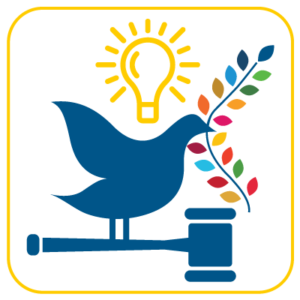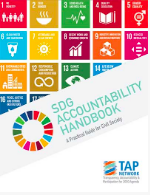SDG coordination bodies play a central role in SDG16+ implementation and thus are critical to engage in order to advance more peaceful, just and inclusive societies
In seeking to support the implementation of SDG16+, your first point of departure will be to identify the main government bodies, entities or coordination mechanisms responsible for SDG implementation. Institutional arrangements for SDG implementation will vary by country in terms of their establishment, form, leadership approach, membership and/or organization.
For example, there may be new bodies created for SDG implementation or pre-existing bodies with an updated mandate to implement the SDGs. In terms of form, there may be an inter-ministerial committee or commission designed to oversee SDG implementation and break down silos across sectors,1 a Head of State or Government office, or a specific ministry designated to spearhead SDG implementation.2 Leadership may also vary, with implementation directed by the Office of the Prime Minister or Presidency, a specific ministry, or some combination of the two. In terms of membership, some bodies may involve only government representatives (e.g. ministers, government department heads, sector focal points, etc.), while others may include both government and non-governmental representatives, including from sub-national levels.3 In some cases, SDG coordination bodies may provide for non-governmental stakeholder participation – including from civil society – through national or technical committees or working groups.4
While they may differ in characteristics, SDG coordination bodies tend to share a similar overarching function, namely to coordinate and oversee the implementation of the SDGs across government ministries, departments and organizations. Given the central role these bodies play in SDG implementation,5 they are critical for civil society to engage with in order to advance the SDG16+ agenda for peaceful, just and inclusive societies.

In order to progress SDG16+ implementation, civil society actors should consider taking the following actions to engage with SDG coordination bodies:
a. Formal meetings – Seek to meet with individual members of SDG coordination bodies or arrange briefings for the entire body in order to share information, ideas and practical recommendations on SDG16+ implementation.7 Encourage members to adopt SDG16+ language and champion specific SDG16+ causes;
8
b. Networking – Build relationships with government officials by networking with them and their staff at formal and informal events. Once initial contact is established, be proactive and maintain regular communication. Building relationships and trust can open the door to opportunities to positively influence SDG16+ implementation;
c. Technical Support – Offer technical support to government bodies in charge of implementing specific SDG16+ targets including research, data and information on SDG16+ implementation in other countries and training for government officials on SDG16+ issues. You may also wish to provide secondment of expert advisors on SDG16+ issues to specific government departments or ministries. Such support may be particularly valued and appreciated in countries where resources for SDG implementation are limited; and
d. Facilitating Input – Consult with people, especially vulnerable and marginalized groups, for their views on SDG16+ implementation and share their feedback with government officials. Remember to report back to those consulted on how their inputs were received and how they will be used to advance SDG16+ implementation.

TIP: Identifying and engaging with government officials
TIP: Identifying and engaging with government officials

Case Study


Case Study
Identifying National-Level Institutions Implementing the SDGs9
SDG Accountability Handbook
The Ministry of Devolution and Planning in Kenya is mandated to coordinate the implementation and monitoring of the SDGs. The SDGs Coordinating Department has been established within the Ministry, supported by an Inter-Agency Technical Committee (IATC) comprising officers from key government ministries, CSOs and the private sector. For ownership and ease of follow-up, entry points for the private sector, CSOs, subnational governments, youth and persons with disabilities are typically their respective umbrella bodies, such as Kenya Private Sector Alliance (KEPSA), SDG Kenya Forum, the Council of Governors (CoG), National Youth Council and the Association of Persons Living with Disabilities10
SDG Accountability Handbook: A Practical Guide for Civil Society (TAP Network, 2018)
This handbook provides guidance on the different approaches and steps that can be taken by civil society to ensure national government accountability for the SDGs. It includes a chapter on ‘Connecting with Designated Government SDG Bodies and Ministries.’ Available at: https://sdgaccountability.org/

This section of the website for the HLPF provides a list of all countries that have participated in a Voluntary National Review (VNR) with many country reports outlining their governance and institutional arrangements for SDG implementation. Focal points for countries that have presented or will present a VNR are identified under a separate tab.
Available at: https://sustainabledevelopment.un.org/vnrs/
This series of reports documents national institutional arrangements for implementing the SDGs in countries that presented VNRs from 2016-2019.
Available at:
●https://sustainabledevelopment.un.org/content/documents/25839Compendium_of_National_Institutional_Arrangements.pdf (2019)
●https://publicadministration.un.org/publications/content/featured_titles/compendium_nia_sdg%202019.html (2018)
●https://publicadministration.un.org/publications/content/featured_titles/compendium_nia_sdg.html (2016 and 2017)
This annual series of reports, commissioned by civil society and published by Cooperation Canada (formally the Canadian Council for International Co-operation), provides an independent analysis of VNR reports submitted to the HLPF, including outlining the governance and institutional arrangements of countries.
Available at:
● https://cooperation.ca/2030agenda/ (2018, 2019 and 2020)
● https://cooperation.ca/progressing-national-sdgs-impementation/ (2017)
This paper analyzes a range of coordinating structures for implementing the SDGs, including both new and adapted structures. The characteristics of coordinating structures – including their leadership approach, membership, organization and main functions – are discussed. Structural and functional limitations that may hamper the continuous and coherent implementation and review of the 2030 Agenda are also identified.
Available at: https://www.partners-for-review.de/wp-content/uploads/2019/09/Whole-of-Government-P4R-Discussion-paper-2019.pdf
This guidance note provides information on how countries have adapted their existing institutional and coordination frameworks or established new ones in order to implement the SDGs. It includes information on how responsibility is allocated among various levels of government for coherent implementation and review of the 2030 Agenda. Country case studies are also provided.
Available at: https://sustainabledevelopment.un.org/content/documents/2478Institutional_Coordination_Mechanisms_GuidanceNote.pdf
Transparency, Accountability &
Participation (TAP) Network
Address: 205 E 42nd St.
New York, NY 10017
Email:
secretariat@tapnetwork2030.org